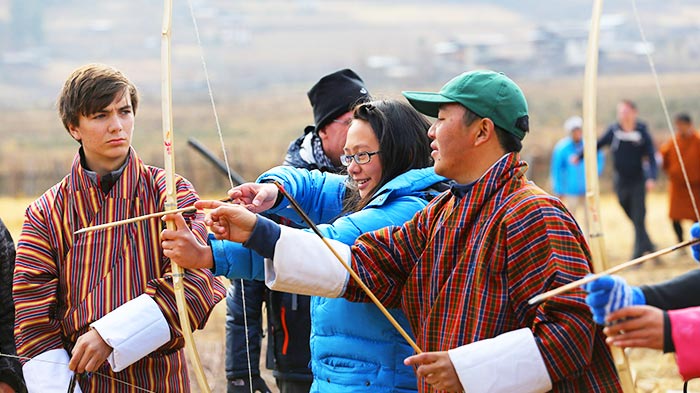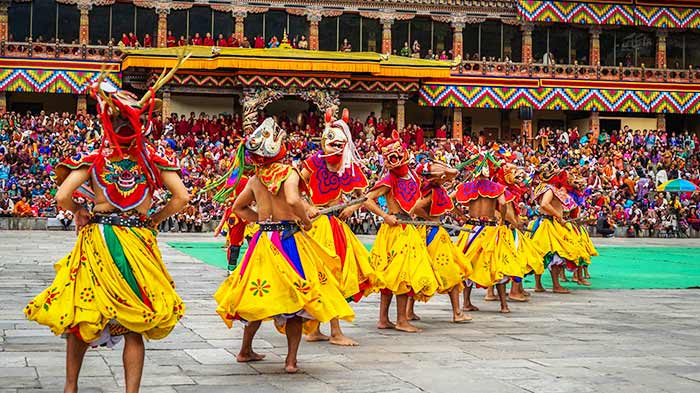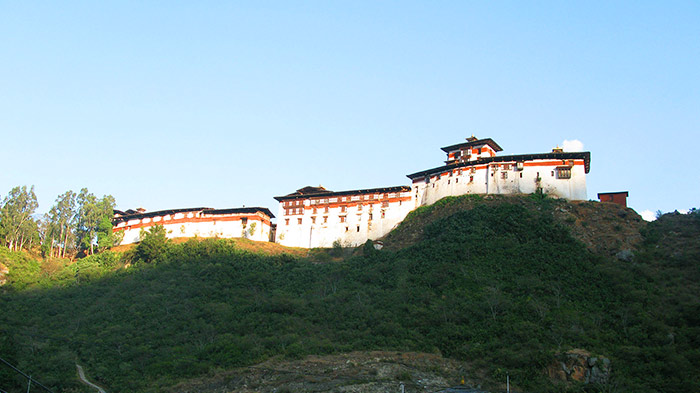
Top 10 Things to Do for Bhutan Travel
Sitting in the beauty of the mighty Himalayas, Bhutan’s northern border shares the Himalayan Mountains with Tibet, with India on its other borders. Known as the last remaining Shangri-La for the stunning landscapes and ancient forests, Bhutan has seen centuries of isolation from the outside world, and until recently refused to allow foreign travelers to enter the kingdom.
Though pretty small in size, Bhutan is unspoiled Himalayan backyard secret garden, peppered with sacred Buddhist sites and idyllic mountain trails and profound handicraft culture, etc. for exploration. Before you pack your luggage and hit the road for this virgin land, there are top 10 things you can exprence, which will leave you in breathless with their awesome beauty.
Archery
The national sport of Bhutan, archery is an important part of every person’s life in the kingdom, and they are passionate about the sport. Across the entire country, you can find groups of men in the traditional colorful ghos (a style of Bhutanese men’s robes) shooting arrows at targets as far away as around 140 meters. Every village in the kingdom has its own archery field, and when local tournaments take place, entire villages turn out in their best finery, while the women dance, sing, and cheer for their men, and the villagers of the opposing team heckle them while they shoot. This amazing spectacle of boisterous cheering and derision is just as entertaining to many visitors as the matches themselves, and it is a popular sight to see when visiting Bhutan.
 Archery is a national sport in Bhutan
Archery is a national sport in Bhutan
The Tiger’s Nest
Only in Bhutan could a tiger actually have a nest, and one that is around 900 meters up the sheer face of the cliff that overlooks the Paro Valley. Known as the Taktsang Lhakhang, or Tiger’s Nest Monastery, it is one of the most popular tourist sites in Bhutan, it never feels overrun or crowded, thanks to the restrictions on the number of concurrent visitors. Plus, of course, the arduous and lung-churning trek up the steep cliff face to reach the monastery. The narrow ledge on the cliff face was the chosen spot for the Guru Rinpoche for his meditations period of three years, three months, three weeks, three days, and three hours. It is believed that he flew to Bhutan in the 8th century on the back of a giant tiger, and while the climb may be arduous, it is worth it for the amazing view from the ledge of rock.
Dochula Pass
Located on the road from Thimphu to Punakha, the Dochula Pass, at 3,100 meters, offers one of the most stunning three-hundred and sixty degree views in the world. Covered with snow for most of the year, the pass is the location of the 108 memorial chortens that were built to commemorate the fourth Druk Gyalpo, the head of state of Bhutan. The view from the Chortens is stunning, even on days with clouds, and on clear days, the mighty Himalayas form a spectacular backdrop to the chortens.
Punakha Dzong
Known as the Palace of Great Bliss, or Punthang Dechen Phodrang, this stunning monastery was built in 1637 by the first Zhabdrung Rinpoche, and lies on the banks of the Puna Tsang Chu River. The Machen Lhakhang inside the dzong holds the remains of the Zhabdrung, and the dzong was the place where the first king of Bhutan, Ugyen Wangchuck was crowned in 1907. A smaller dzong, known as the little dzong or Dzongchung, was built on the opposite bank in 1328, facing the Punakha Dzong, by the Bhutanese saint, Ngagi Rinchen.
Thimphu Tsechu
Thimphu Tsechu is one of the biggest of all the Bhutanese festivals, and is help in the capital for three day from the 10th day of the 8th lunar month. The original festival started in 1867, and was just a few monks dancing the various cham dances. In more recent years, the festival has become somewhat more colorful, with a wider variety of the mask dances, entertainment from the Atsaras that provides protection from evil spirits during the festival, and stage theater shows. The monastic horns ring out from the temple, heard throughout the valley, and the constant drum-beat follows the parading dancers as they whirl around the arena, monks subduing demons, and demons battling back. A festival that is believed can gain one merit, the people arrive for the tsechu dressed in traditional Bhutanese costume, complete with fine jewelry.
 Celebrating Thimphu Tsechu with Cham dance
Celebrating Thimphu Tsechu with Cham dance
The Druk Path
One of the finest treks in Bhutan, the Druk Path runs from Thimphu to Paro, between high, misty mountains, past shimmering lakes, and through lush green pastures. A popular trek, it is also the route of many yak herders, who move their herds from plain to grassy plain for the best grazing. The trek heads through apple orchards as it makes its way higher into the mountains, and passes through some of Bhutan’s richest rhododendron forests, crossing several passes along the way. Totaling around 56 kilometers in length, the trek takes around five days to complete, and is not too hard for novice trekkers.
National Textile Museum, Art, and Crafts
Located in Thimphu, the capital of Bhutan, the National Textile Museum is a part of the Royal textile Academy, and holds the history of one of Bhutan’s national arts, weaving. Textiles in Bhutan are finely woven, and are valued throughout the region for their quality and style. Known in Bhutanese as “thazgo”, weaving of cloth is a skill that has been developed into a fine art over the centuries. The ground floor of the museum is devoted to the royal clothing, and includes the wedding clothes worn by the fourth Dragon King, Jigme Singye Wangchuck, and his four wives. The second floor is dedicated to the history and techniques of Bhutanese weaving, and includes local dress through the centuries, from traditional to daily wear, and the types of textiles worn by the people. Across the courtyard, you can see local weavers making the cloth in the traditional manner. Photographs are not permitted within the museum, but you can buy some of the locally made textiles from the shop on site, as well as interesting books on how to weave.
Wangdiphodrang
Another popular place with tourists in Bhutan is the town of Wangdiphodrang, located in the south of the Punakha region. The lush Wangdiphodrang Valley is one of the richest pasturelands in the region for grazing cattle, as it sites at the confluence of the Punakha Chhu and Tang Chhu Rivers. Famous for its unique stone and slate carvings, and the huge number of bamboo products made by hand in the region, and sold through the town, it is a great place to visit and explore, and maybe get some souvenirs to take home.
 Wangdiphodrang
Wangdiphodrang
Jhomolhari Trek
The Jhomolhari Trek for your intermediate trekkers, the trek around the base of Mount Jhomolhari in Northern Bhutan is set in the lands of the yak herders, and passes through rich forested valleys and high alpine pastures, with some of the most stunning views of the Himalayas in the world. Starting at the Druk-gyal Dzong, in the upper Paro District, this is the most popular trek in Bhutan, and is the local equivalent of a trek to Everest Base Camp in Nepal. The trek passes along the Paro Chhu Valley for the first two days, before crossing high passes towards the village of Lingshi and the Lingshi Dzong, and finally one last pass before heading down again towards the Thimphu Valley. Around 40 percent of all trekkers in Bhutan make this trek, and there are two separate routes to choose from after the first two days to Jangothang, where the route splits into two, which the Tourism Council of Bhutan class as two separate treks. Best done from April to June or September to November, it is not an ideal trek for the summer months, as the monsoon rains make the paths too muddy to pass along. The trek takes around eight days to complete, including acclimatization days, and reaches altitudes of over 4,900 meters. Further reading about Jomolhari Loop (Soi Yaksa) Trek in Bhutan
Wildlife Yeti Safari
With more than 70 percent of the country being dedicated to natural forests, Bhutan has a huge amount of wildlife living inside its borders, that are all under the protection of the government, and many of which are endangered species. The Sakteng Wildlife Sanctuary, a 740 square mile area of undisturbed wilderness in the east of Bhutan, is home to Bengal tigers and snow leopards, as well as the famous red pandas. And if that is not enough, you can go on an expedition to find the most elusive beast of the Himalayas, the Yeti. The most famous myth of the Himalayas, the yeti is known in Bhutan as the “migoi”, and has a strong hold on the local culture. Every small town and village has its own tales of people who have encountered the migoi, and can tell you how to escape its wrath for trespassing on its territory. One of the greatest legends of the Himalayas, while you may not find one, it is fun to go out and try.

I am a tour guide in Tibet an was Born in Kham Tibet, I am the father of 2 little girls, bachelor's degree. I have more than 7-years experience of being a tour guide in Tibet. I am a warm, friendly, knowledgeable and attractive guy.


.jpg)



0 Comment ON "Top 10 Things to Do for Bhutan Travel"